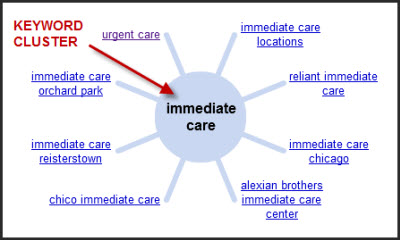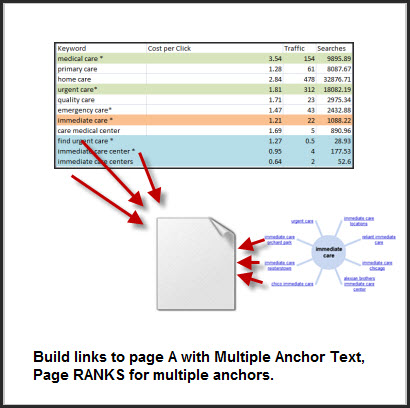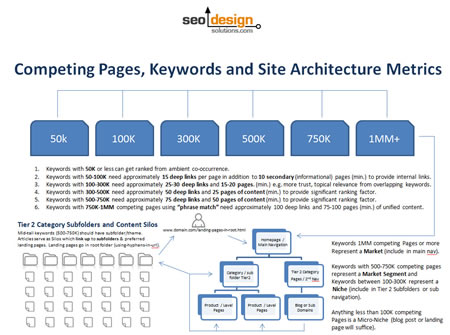Today’s SEO tip is a link building strategy based on how to promote keyword stemming (ranking a page for multiple keywords).

SEO Link Building Strategies
Specifically this tactic pertains to anchor text selection and execution. Keep in mind, Google ranks pages not websites, hence the more authoritative a page is (based on other internal pages and links or deep links from other sites) determines how visible that page is (for specific or related keywords) depending on your tactical link building approach.
There are a few fundamentals to consider such as link type (RSS, one way, reciprocal, internal), link velocity (the rate that you gain or lose links) anchor text selection (narrow, broad, exact-match or diverse) and the source / theme of the link (similar site, unrelated niche, authoritative or bad neighborhood). If you have the proper range, then it merely becomes a matter of staggered execution and moderation per keyword to provide buoyancy in the SERPs (search engine result pages).
How to promote keyword stemming:
- Find the cluster of keywords you want a PAGE to rank for.
- Create an array of internal links from prominent pages which ideally have the target keyword in the title, URL, H1 or on page content.
- Create internal links with a percentage of inbound anchor text from the original keyword cluster.
- Build a percentage of external inbound links (deep links from other sites) with the preferred anchor text the target page should rank for.
- Let the page age, then apply additional on-site or off-site leverage over time (keeping in mind link attrition, query deserves freshness and competitive thresholds).
Step 1: Identify the keywords or keyword cluster using keyword research, the wonder wheel or related search.

Keyword Cluster from Google's Wonder Wheel
Step 2: Map out the threshold of on page and off page factors; here is a sample set of “content to link ratios” below (click image to visit post) that you can utilize as a preliminary step until you assess and refine your own unique thresholds and metrics.
Step 3: Content creation or leveraging legacy content to provide internal link-flow for a plethora of inbound anchor text. You can also refer to the post SEO Rankings and How to Create Them for additional insight on this link building tactic.
Step 4: Map anchors to internal pages and map out an off page ranking strategy based on the different types of links required and implement a natural link velocity not exceeding the age or authority of your website for any given keyword.

Mapping Anchor Text to Landing Pages
For example, building 10,000 links to a website with one keyword is NOT natural, or even applicable for a new website with no history or trust. A seasoned authority site may be able to weather 50% of that type of link-load without blinking and have it translate into rankings, however, that is because it has (a) high traffic volume (b) a high degree of citation and (c) it has earned its authoritative position.
For a new site 100 links per month is pushing it for one anchor, so each keyword should be mapped out not to exceed a normal threshold to invoke a penalty. Google can determine if spikes or link clusters are all getting indexed in a short period of time, so, exercise caution in building links with a wild west approach, however, it is your right to promote your business and Google and other search engines ARE NOT the only traffic source online.
Although they are the most prominent source for conversion for many, you still have the right to promote and syndicate your content through links. Since links are the only way we can move from page to page and site to site and THEY DID exist BEFORE Google and other search engines and were factored into the link graph and equation from their engineers as a metric does not mean that the web should change to accommodate them.
Just be mindful of the type of link building and the quality of the traffic sources that would be exposed to those links as links have a dual purpose (1) to build relevance for specific keywords and (2) to pass traffic along to the target URL. Both types of link metrics (traffic and authority) are equally important, hence it is highly improbable that 80% of the web even knows what the difference between do-follow, no-follow, sponsored or not.
Step 5: Let the synergy age and results synthesize so that increased search engine result page positioning can occur as a result of the recipes blending the needed ingredients into each page has a chance to evolve and express itself after a suitable chrysalis phase.










Really nice strategies for keyword targeted search ranking, The information would very helpful in generating page rank and multiple keywords ranking.
Thanks for u r information
its very useful
Link building is so much work! I also think it is good to track your links with a backlink checker to make sure none of your links die on you. Don’t links get better for you over time?
You mention that the site should ‘age’ for a while before adding more links.
Does anyone know what type of time frame is appropriate? Days? Weeks? Or (heaven forbid) months?
Just start slow and stagger the links gradually to add more over time. This is known as link velocity and be sure to diversify the anchor text and not exceed a comfortable range of “instances” for each exact match anchor text. The older the site, the more instances you can build per month i.e. 3 links per keyword per month, 7 links per keyword per month, 12 links per keyword per month, etc. Just build over time.